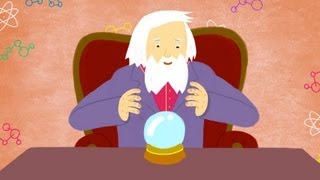(单词翻译:单击)
The periodic table is instantly recognizable.
人们一眼就能认出周期表。
It's not just in every chemistry lab worldwide, it's found on t-shirts, coffee mugs, and shower curtains.
它不只存在于全球每间化学实研室,还在T恤、咖啡杯及浴帘上出现。
But the periodic table isn't just another trendy icon.
但周期表并不只是另一个时尚图像。
It's a massive slab of human genius, up there with the Taj Mahal, the Mona Lisa, and the ice cream sandwich
它是人类才华的大集合,可以与泰姬玛哈陵、蒙娜莉萨的微笑及冰淇淋三明治相媲
and the table's creator, Dmitri Mendeleev, is a bonafide science hall-of-famer.
而此表的创造者--德米特里·门捷列夫,是位货真价实的名人堂成员。
But why? What's so great about him and his table?
但此话怎讲?他本人及其周期表有什么伟大之处?
Is it because he made a comprehensive list of the known elements?
就因为他对已知元素作出了一张总表?
Nah, you don't earn a spot in science Valhalla just for making a list.
才不是,你决不会因为弄了张列表就进了科学名人堂。
Besides, Mendeleev was far from the first person to do that.
况且门捷列夫根本不是第一个做这事的人。
Is it because Mendeleev arranged elements with similar properties together?
那是因为门捷列夫以相似性质来排列元素?
Not really, that had already been done too. So what was Mendeleev's genius?
也不尽然,在他之前也有人做过了。所以到底门捷列夫天才在哪里?
Let's look at one of the first versions of the periodic table from around 1870.
让我们看一下约在1870年所创的第一个元素周期表。
Here we see elements designated by their two-letter symbols arranged in a table.
这里我们看见元素以他们的英文简写排列在一张表里。
Check out the entry of the third column, fifth row. There's a dash there.
来看看第三行第五排这项。这有条横杠。
From that unassuming placeholder springs the raw brilliance of Mendeleev. That dash is science.
从这个预留的位置,显露出门捷列夫的聪明才智。这就是科学!
By putting that dash there, Dmitri was making a bold statement.
门捷列夫以那条横杠做出一项大胆的声明。

He said -- and I'm paraphrasing here --
他说--我来转述一下大致意思--
Y'all haven't discovered this element yet. In the meantime, I'm going to give it a name.
虽诸君尚未发现此元素,但鄙人要在此替它命名。
It's one step away from aluminum, so we'll call it eka-aluminum, 'eka' being Sanskrit for one.
此元素在类铝一格,所以我们要称它为‘eka-铝’(类铝),‘eka’来自梵语,即‘一’的意思。
Nobody's found eka-aluminum yet, so we don't know anything about it, right?
这个类铝元素尚未被发现,所以我们应该对其一无所知。对吧?
Wrong! Based on where it's located, I can tell you all about it.
错!我可以凭它在周期表的位置来告诉你它的一切。
First of all, an atom of eka-aluminum has an atomic weight of 68, about 68 times heavier than a hydrogen atom.
第一,类铝的原子量为68,比氢原子重约68倍。
When eka-aluminum is isolated, you'll see it's a solid metal at room temperature.
类铝元素被分离出来时,你会看到它在室温下为固态金属。
It's shiny, it conducts heat really well, it can be flattened into a sheet, stretched into a wire,
它具金属光泽,导热性很好,它能被延展成薄片,拉长成缆线,
but its melting point is low. Like, freakishly low.
但是它的熔点很低,简直是低得吓人。
Oh, and a cubic centimeter of it will weigh six grams.
喔,而且它每立方厘米只有六克重。
Mendeleev could predict all of these things simply from where the blank spot was,
门捷列夫可以仅凭空格的位置来预测这些东西,
and his understanding of how the elements surrounding it behave.
而且他了解围绕在它四周元素的特性。
A few years after this prediction,
在他作了这项预测几年之后,
a French guy named Paul Emile Lecoq de Boisbaudran discovered a new element in ore samples
有个叫保罗·埃米尔·勒科克·德布瓦博德兰的法国人,在矿砂样品发现了一种新元素,
and named it gallium after Gaul, the historical name for France.
并将其命名为‘镓’,以纪念法国的历史名称‘高卢’。
Gallium is one step away from aluminum on the periodic table. It's eka-aluminum.
镓在周期表上距离一格,所以它是类铝元素。
So were Mendeleev's predictions right?
所以门捷列夫的预测对吗?
Gallium's atomic weight is 69.72. A cubic centimeter of it weighs 5.9 grams.
镓的原子量为69.72,每立方厘米重5.9克。
It's a solid metal at room temperature, but it melts at a paltry 30 degrees Celcius, 85 degrees Fahrenheit.
在室温为固态金属,但在30摄氏度(也就是华氏85度)这么不起眼的温度下即熔化。
It melts in your mouth and in your hand.
它熔于你口,也熔于你手。
Not only did Mendeleev completely nail gallium, he predicted other elements that were unknown at the time: scandium, germanium, rhenium.
门捷列夫不仅完全猜到镓,他还预测了其它当时尚未知的元素:钪、锗、铼。
The element he called eka-manganese is now called technetium.
他当时称为‘类锰’的元素,现在称作锝。
Technetium is so rare it couldn't be isolated until it was synthesized in a cyclotron in 1937,
锝是如此稀有,直到1937年才在回旋加速器中被人合成并分离出来,
almost 70 years after Dmitri predicted its existence, 30 years after he died.
这几乎是门捷列夫预测其存在70年后了,即他死后30年。
Dmitri died without a Nobel Prize in 1907, but he wound up receiving a much more exclusive honor.
门捷列夫到1907年去世前都与诺贝尔奖无缘,但他后来得到一项殊荣。
In 1955, scientists at UC Berkeley successfully created 17 atoms of a previously undiscovered element.
1955年,加州大学柏克莱分校的科学家成功创造出17种之前未发现的元素。
This element filled an empty spot in the perodic table at number 101, and was officially named Mendelevium in 1963.
这个填在周期表上101空位的元素,1963年被正式命名为钔。
There have been well over 800 Nobel Prize winners, but only 15 scientists have an element named after them.
诺贝尔奖有超过800位得主,但只有15名科学家拥有以他们为名的元素。
So the next time you stare at a periodic table, whether it's on the wall of a university classroom or on a five-dollar coffee mug,
所以下回你盯着周期表看时,不论是在大学教室的墙上,或是在五美元的马克杯上,
Dmitri Mendeleev, the architect of the periodic table, will be staring back.
门捷列夫,这位元素周期表的创造人,一定也会回望着你。


